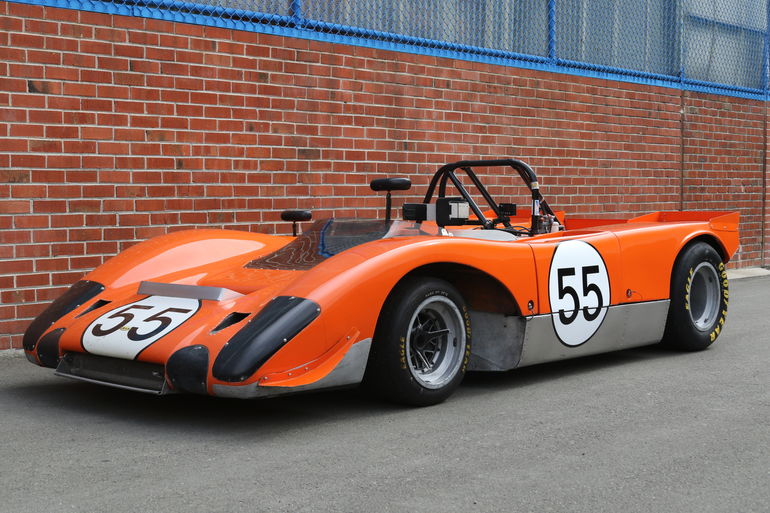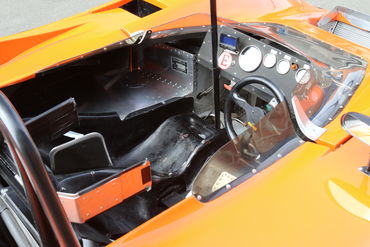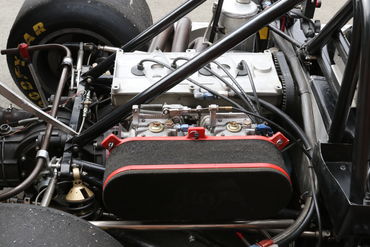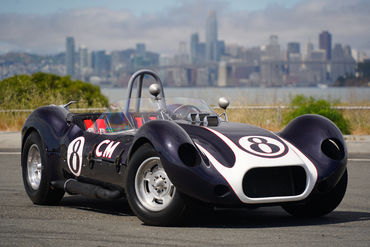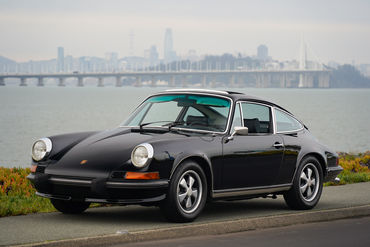Sold
SOLD 02/22
1971 Lola
T212
Driven to 2nd in Class at the 1972 24 Hours of Daytona by Maurice and Roger McCaig. Multiple Historic Racing Victories. Fastidiously Documented, Many extras Included.
- VINHU37
- Exterior Color1972 Daytona Racing Livery #55 Orange
- Interior ColorBlack
- MileageTMU
- Engine2.0L DOHC Cosworth BDG
- Engine no.3901
- TransmissionHewland FT 200 5-Speed
- StatusSold
- StockFJ2414
Description
1972 Lola T212
s/n HU 37
1972 Daytona Racing Livery #55 Orange
With its advanced construction, state of the art technology, and low-profile body designs, Lolas remain among the most important and beautiful racecars ever built. And while many Lola cars were distinctively influential on the design of several other racing cars, including the Ford GT40, the history of their racing endeavors stretches throughout a wide range of cars and classes of racing.
Established in 1958 by Eric Broadley, a brilliant engineer and determined businessman, Lola cars was a fledgling company eager to establish their name in the growing field of competitive motorsports. The UK based company began their engineering developments building front-engine sports cars, rapidly expanding their offerings into more ambitious ventures. A key move for Lola was their ground-breaking development of the Lola Mk6 coupe, fitted with a Ford engine. This car would capture the attention of Ford engineers, who then vociferously tapped Broadley for innovative contributions to the development of the Ford GT40. During this intense two-year period, the GT40 gleaned numerous technical advances including Broadley’s sophisticated construction methods, suspension geometry, and body design.
Broadley’s intense development was further fortified by his exposure to millions of dollars of engineering advances funded by Ford and their juggernaut to win at Le Mans. The early engineering of lightweight yet remarkably robust aluminum monocoque construction, coupled with suspension dynamics and horsepower management, coupled with newly developed mid-engine platforms, culminated in some of the most advanced construction methods in any contemporary race car.
Having been specifically developed for the 2-Liter European Sportscar Championship series, the earlier cars were designed with very simple construction and build so as to allow privateers easy service and repairs as needed, but also for ease of manufacture. The previous T210 had been very successful so the design was refined in preparation for the 1971 season. The T212 was constructed as a Group 6 car, making it eligible for hill climbs, sportscar racing, and endurance races. Typically outfitted with the Ford Cosworth FVC engine, the durability and performance of these engines was perfectly suited for the lightweight aluminum sheet monocoque and rear subframe layout. So suited were these cars for a range of tracks, they summarily appeared at venues as wide ranging as Targa Florio, Nurburgring, Monza 1000, and Brands Hatch, to name but a few. Just 21 T212 models were constructed in period, many of which performed handily against contemporary cars including the Chevron B19, with the Lola T212 winning the Manufacturers Title as well as Driver’s Championship (Helmut Marko).
This particular example, chassis Hu 37 has been authenticated in a few Lola source books and references, several Lola authorities, and by the current owner. It is absolutely the correct T212 constructed and assigned the HU 37 designation when commissioned for construction at Lola. This car was purchased in mid 1971 by two Canadian businessmen, brothers Roger and Maurice McCaig. The brothers were able to persuade Lola to build one more car at the end of the run, making this the last of the T212 model run. The McCaigs were so intent on the build, they dispatched their chief mechanic Paul Cook to the UK to cast a watchful eye over the build of HU 37, both at Lola, Hewland, and other vendors. As much had been learned in the construction and previous campaigning of T210 and 212 series cars, this chassis was constructed using thicker gauge aluminum, which increased the structural rigidity and reduced stress cracking. The chassis was fitted with a special taller quick-fill fuel neck, and a specially constructed dashboard, extra gauges, and re-settable fuses. The exterior included NACA duct intakes, larger rear hubs, and special nose lighting, all of which remain on the car today. Additional unique features were a part of the factory construction, but several other features were also added during the McCaig campaign for Daytona 1972 and other venues.
HU 37 finished 9th overall and 2nd in class at the 1972 Daytona Endurance Race, driven by the McCaig brothers. Further events included attendance at Sebring, Mosport, and Watkins Glen in 1972. After racing the car, the McCaigs went on to compete in Can-Am and Formula Atlantic, sidelining HU 37 still bearing #55 from period racing. During a race at Watkins Glen, the car was involved in an incident which damaged the magnesium right rear hub. This suspension component, an integral part of the history and originality of HU 37 has been crack tested on an ongoing basis as it still remains on the car to this day. This, among other components supporting the original condition, have been documented and supported by subsequent owners who have enjoyed HU 37 respectfully, while retaining the mechanical and cosmetic features to an authentic and current motorsport standard.
As part of the history of this car, it was purchased by racers Dave Rolo, Ian Carpenter, and J. Busby. Busby engaged Tony Ingram to extensively freshen the car in the 1980s in order to bring it up to racing standards. Unbeknownst to him, during this process, a rogue mechanic, unfortunately trusted by Ingram, managed to purloin the original chassis plate while being serviced. The mechanic then brazenly approached Busby suggesting that he would be well-advised to buy it back, holding the original plate hostage. Busby emphatically refused the effrontery, demanding the plate be returned to its rightful owner. Unfortunately, the appropriate return of the property did not materialize and instead, the original HU 37 plate found another buyer, summarily mounted to a fabricated replica, constructed from spares and reproduction components, bearing the chassis plate improperly removed from this documented and correct factory car. The errant replica while still extant, is fortunately identified by numerous Lola authorities as a replica. The same authorities cite the true origins of this #55 livery Daytona T212 as the proper factory built car.
The current owner purchased this car in 2001 and has raced it since 20o2. As part of the races dating back to the 1990s, reported in the logbooks accompanying the car, the car was very competitive, often beating Can Am cars on tracks with shorter straights. The racing history under current ownership includes a remarkable 106 week-end vintage races spanning 2002-2017 including events at Daytona, Sebring, Road America, Seattle, Portland, Coronado, Button Willow, Willow Springs, Fontana, Phoenix, Las Vegas (in two different configurations), Sears Point, Laguna Seca, etc with numerous class and overall victories. The last race competitively run was completed in February 2017, winning overall at Spring Mountain.
Since 2004, Chris Harrison of Harrison Autodynamics has been the primary caretaker for HU 37, all under current ownership, working both on and off the track for the past sixteen years. During his time with the car, the goal was to maintain this car with as much attention to originality while still remaining safe and competitive as a racecar. As such, the car has retained the original Lola built tub with the correct stepped floor (absent in T212 replicas) allowing for minor repairs, including the left side tub skin replaced in 2016. The car is set up with a factory seat with added bracing and headrest able to accommodate a taller driver (6’ 1”) with a taller windscreen installed in 2015. Although the body is of original endurance specifications and still retains the McCaig era headlight buckets and vents, front dive planes and more rear spoiler have been added (easily removable should the new owner wish). The car retains original configuration Girling 2 piston caliper brakes with new hats and rotors. The Lola mag wheels received new spun aluminum inner rim halves in 2009 (2 sets were done – spares included) retaining the original winged knock-on nuts and a spare set of hex nuts. The car was outfitted with Penske DA 7500 series non reservoir shock absorbers, replacing the older Koni 8212 emulsion shocks. Additional improvements include a new Aerotech fuel cell in 2010 and recent inspection, stainless steel headers installed in 2009, conversion to CV joints (old ¼ shafts retained), and a Coast Fab muffler.
Currently the car is outfitted with a two-liter BDG engine with an aluminum nickasil block built by S. Jennings. The build for this motor included the very best available including a round tooth cam drive, light flywheel, rods, and crank, a billet distributor with MSD ignition, and a Jennings billet engine adaptor. This engine was prepared essentially on a cost-no-object basis totaling over $30k when initially installed in 2014. Subsequent rebuilds performed as needed with the most recent freshen by VDS Engines (previously all performed by Jennings) in 2017. Since the last race, the car has been safely stored with straight coolant and a few gallons of C14, started regularly, and checked for general condition.
The car is outfitted with an AIM data logger and HD SmartyCAM Evo 4. Documentation includes a wide range of items including original Lola blueprints, both full size drawings and scaled reference prints, which support the unique features of this T212. Also included in the documentation are numerous correspondences clarifying the stolen chassis plate, multiple magazine articles featuring the car, an ACCUS FIA/USA Historic Technical Passport, HMSA and SVRA logbooks, and numerous reference materials documenting the McCaig brothers period racing with HU 37. A listing of the mechanical spares is summarized at the close of this description.
Today this historically important Lola has been faithfully cared for retaining the original and correct stepped down tub and other key unique features of HU 37, constructed by Lola, commissioned and raced by the McCaig brothers, and campaigned in 1972 at Daytona. With absolutely no dispute regarding the documented provenance in period racing or as raced over the past two decades, the current cosmetic condition is reflective of racing duty with just the right amount of competition patina to the paint and mechanical components, while retaining the same livery as campaigned under the McCaig era. The low-slung open body configuration sports #55 livery, vivid orange paint, and an enticing view of the powerful mid-mounted engine. The exceptional attention to detail to the mechanical features is evident throughout the car. The unique T212 bodywork with McCaig features is beautifully shaped with diving front fenders blended into flatter planed top surfaces and bladed rear air foils, to achieve efficient downforce at high speeds. The paintwork overall is glossy overall, with a host of well-earned blemishes, typical of vintage competition use confidently dispatched over the past 20 years. The cosmetic condition is honestly presented, much as one might have seen in period races from the 1970s. The wheels and tires are in excellent condition, appropriately sized and flush fit under the beautiful aerodynamic body. The tinted lenses, lighting, windscreen and side windows are also in good condition.
The cockpit is clean and very well laid out with excellent driving position, a contoured driver’s seat and passenger seat, and seat belts dated July 2016. A fire suppression system is also professionally installed. It is important to note that the seating comfort for the driver is quite good especially now fitted with the slightly taller windscreen. The current owner, at 6’ 1”, has plenty of legroom and ample seating flexibility, as witnessed by the many races the current owner comfortably completed in this car.
Hinging back the rear body panel, the cleverly engineered mechanical components are revealed. The properly sorted suspension, professionally prepared engine, and expert care afforded during documented ownership presents with confidence. The engine compartment is purposeful and tidy, ready to offer both power and durability to capable drivers. The exposed mechanicals of the front section further reveal a very clean car, displaying the correct riveted aluminum tub and substructure, exposed suspension, and lightweight radiator. Although this car has been expertly prepared with full safety equipment, we recommend a professional race shop perform an inspection and review of all systems before competing in a motorsports setting.
As previously mentioned, the car is accompanied by numerous pieces of printed documentation and the following spares which are copious, well-boxed, and properly labeled.
Original parts used in Daytona 1972 (not used today):
Pulley driven alternator (back of gearbox) for night races
Side mirrors (seen in period photos)
Bucket circles holding the headlights
Perspex clear covers for aux. lights and template for forming spares
Hewland gearbox oil pump drive (endurance race use only)
Original seat cover
Additional spares:
Spare distributor
(2) MSD ignition control units, one new, one used but checked OK
Distributor cap and coil
Rev limiter chips
Radiator caps
Spare starter motor
New fuel pump, assorted fittings and regulator
Cam cover gasket
New air filter
(2) Oil filters
(40) Spark plugs
Spark plug wrench
Spare front winglets
Large “55” number stickers
(4) Brake rotors, spacers, wheel nuts
New brake pads – multiple sets
Wheel bearings, seals, caliper seals, clutch seals
Old ¼ shafts (car converted to CV joints for safety)
Old oil filter canister (car converted to spin-on type filter)
Exhaust and suspension parts (used with three bolt header)
Old oil cooler
(20) sets of gears, dog rings, track charts (boxed and labeled)
Ron Davis spare aluminum radiator
Three bolt header
Display board with photos of Daytona 1972
(4) Wheels with Avon tires mounted
Lola factory blueprints
This is a fantastic opportunity to acquire an historically correct and copiously documented factory-built example of the last competitive Lola T212. Having been expertly campaigned both in period and in vintage events, combined with superlative mechanical preparation, this Lola will confidently run at the head of the pack in many events, just as it has repeatedly done so in scores of recent races. The exceptional mechanical condition, known ownership history, period correct Daytona livery, and the historic importance of factory construction figure prominently in the rarity and usability of this exceptionally well sorted and important Lola T212.
The above vehicle information is complete and accurate to the best of our knowledge at the time it is posted to this website. Corrections or additional information is always appreciated. All advertised prices exclude government fees and taxes, any finance charges, any dealer document preparation charge, and any emission testing charge. Vehicles are subject to prior sale. All advertised to be true but not guaranteed. We assume no liability for errors or omissions.
Inquire About This Car
Fantasy Junction • 510-653-7555 • 1145 Park Ave, Emeryville, CA 94608
